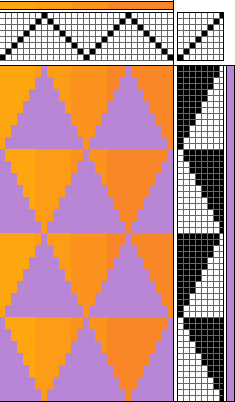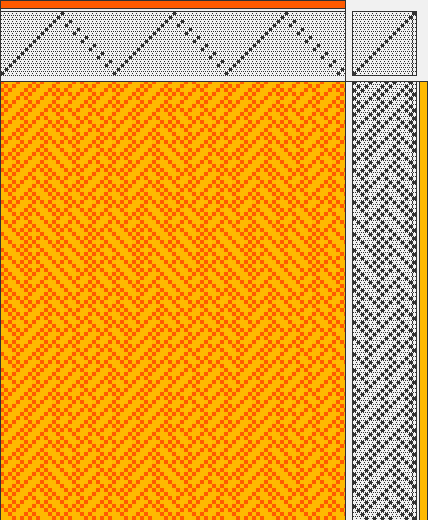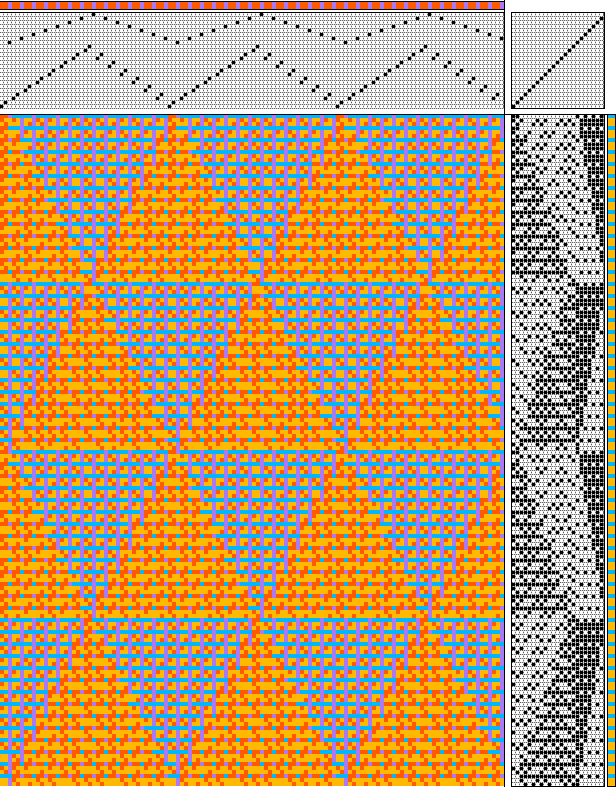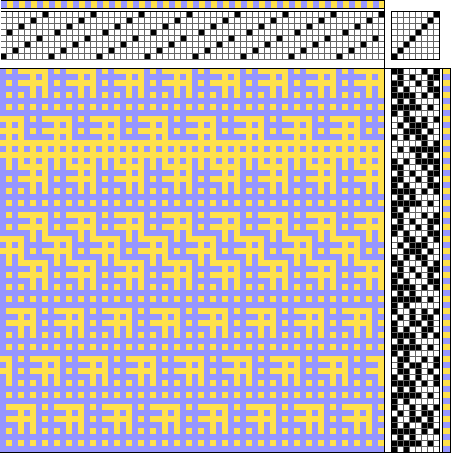In 1995, I took the summer course “Weaving Complex Structures” taught by Susan Sklarek at the Rhode Island School of Design. The course focuses on computer aided fabric design for 24 shaft dobby looms. The double weave section included a technique for hand drafting 12 block double weave designs for 24 shaft straight draw threadings. Susan mentioned that using expanded threadings would result in wider repeats, but didn’t go into this further.
Using a reversed threading seemed a safe way to almost double the width of the repeat. In our hand crafted drafts, we’d limited ourselves to structures with 4×4 repeats such as 4-shaft twill units. As I had 12 shafts per layer, I wanted to try a larger scale structure in at least one of the layers. This led to the idea of weaving a fine thread 16 shaft twill in one layer while using the other 8 shafts to weave a simpler structure in thick threads.
I worked out the simple 8 block profile on a reverse threading shown on the right and started to hand draft it as a thick and thin tabby double weave for 24 shafts. Part way through the process, the light dawned. The only significant information the hand draft was adding to the drafts for the individual layers was which layer was on top at every block of the profile. If this information could be dealt with separately, it would greatly simplify the design process

Leslie Voiers taught a class on 8-shaft double weave design at the 1995 New England Weavers Seminar. She’d just come up with the idea of designing the ends of each layer in a block on adjacent shafts as an aid in visualizing the resulting structure. Using a divided threading to simplify designing double weave liftplans seems a natural extension of her approach.
For my 8 shaft thick thread layer, I chose to keep things simple and use tabby. For the 16 shaft layer, I wanted a twill that would give a flame like effect. Using a reverse threading with a tieup by Bonnie Inouye, I tried several treadlings and settled on a 5 end advancing twill treadling that had a 80 pick repeat.
When it came time to enter the divided threading, I realized the twill layer threading could not be a simple reversed threading and still interleave properly with the 8 shaft reverse threading. Luckily, the twill liftplan worked well enough with the revised twill layer threading for me to go ahead and use it.

The layer structure liftplan was created by interleaving 2:1 the twill liftplan on shafts 1 through 16 with a tabby liftplan on shafts 17 through 24 using the Macintosh weaving program SwiftWeave, which is no longer commercially available.

Creating the layer interchange liftplan took a few more steps. As the tabby layer ends must be raised over two picks of twill between tabby shots, the profile liftplan was interleaved with itself and then shifted over to shafts 17 through 24.
The interchange information for the twill layer started out as the inverse of the profile liftplan and was then extended by hand to double its width. I couldn’t find a way to accomplish this vertical interleaving automatically with the software I have.
The interchange liftplans for the two layers were then interleaved 2:1 to complete the layer interchange liftplan.

The liftplans for the layer structure and layer interchange were overlaid to produce the liftplan in the draft that follows. I wove a sample of this and was happy to see it worked structurally. You may download a WIF file for this draft.

Applying this divided threading double weave design technique to 8 shafts, resulted in the following 4 block profile and double weave draft, which I have not woven.
![]()

An early version of this article appeared in the February 1997 newsletter of the Complex Weaver’s Computer Aided Design Exchange study group.
